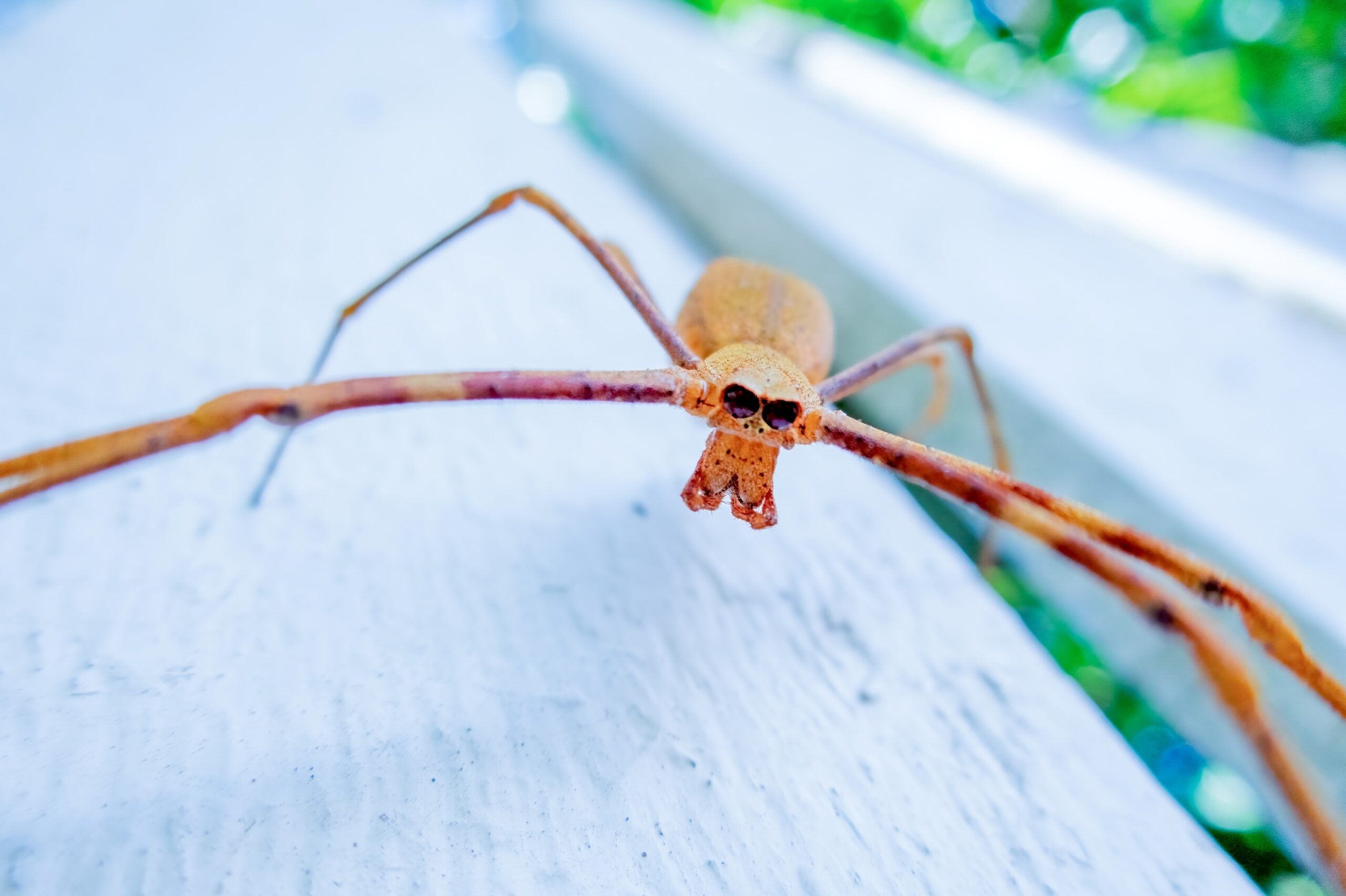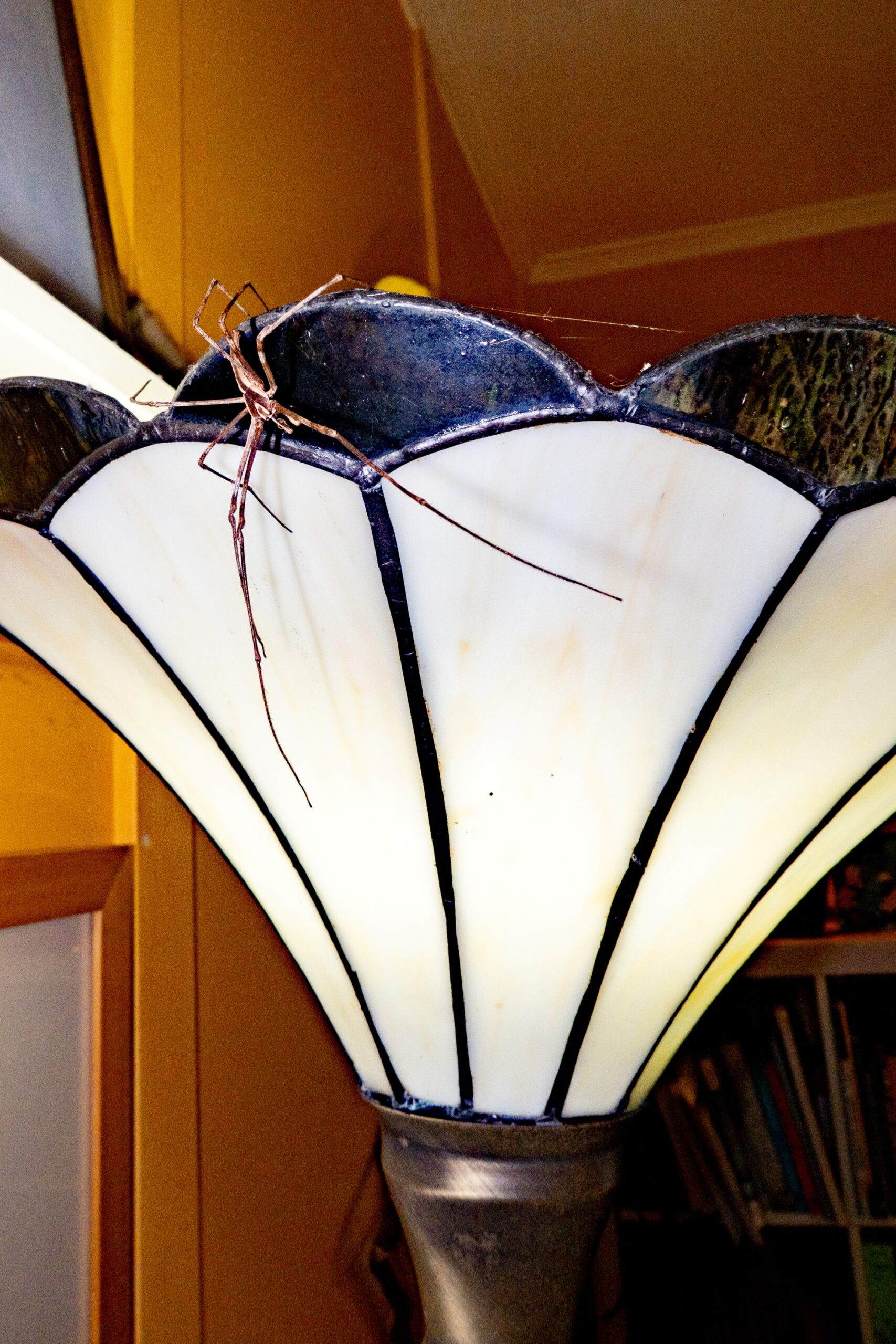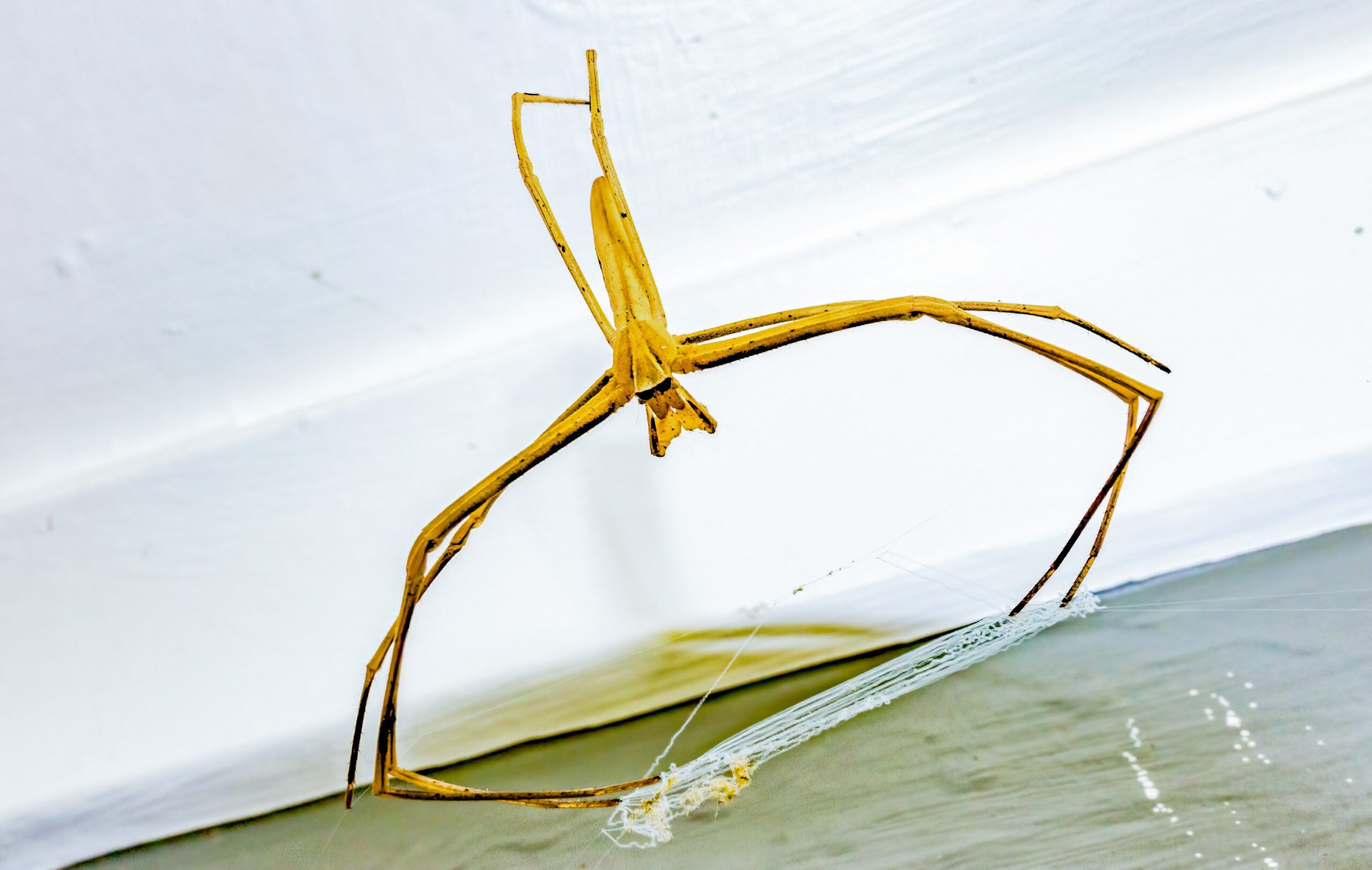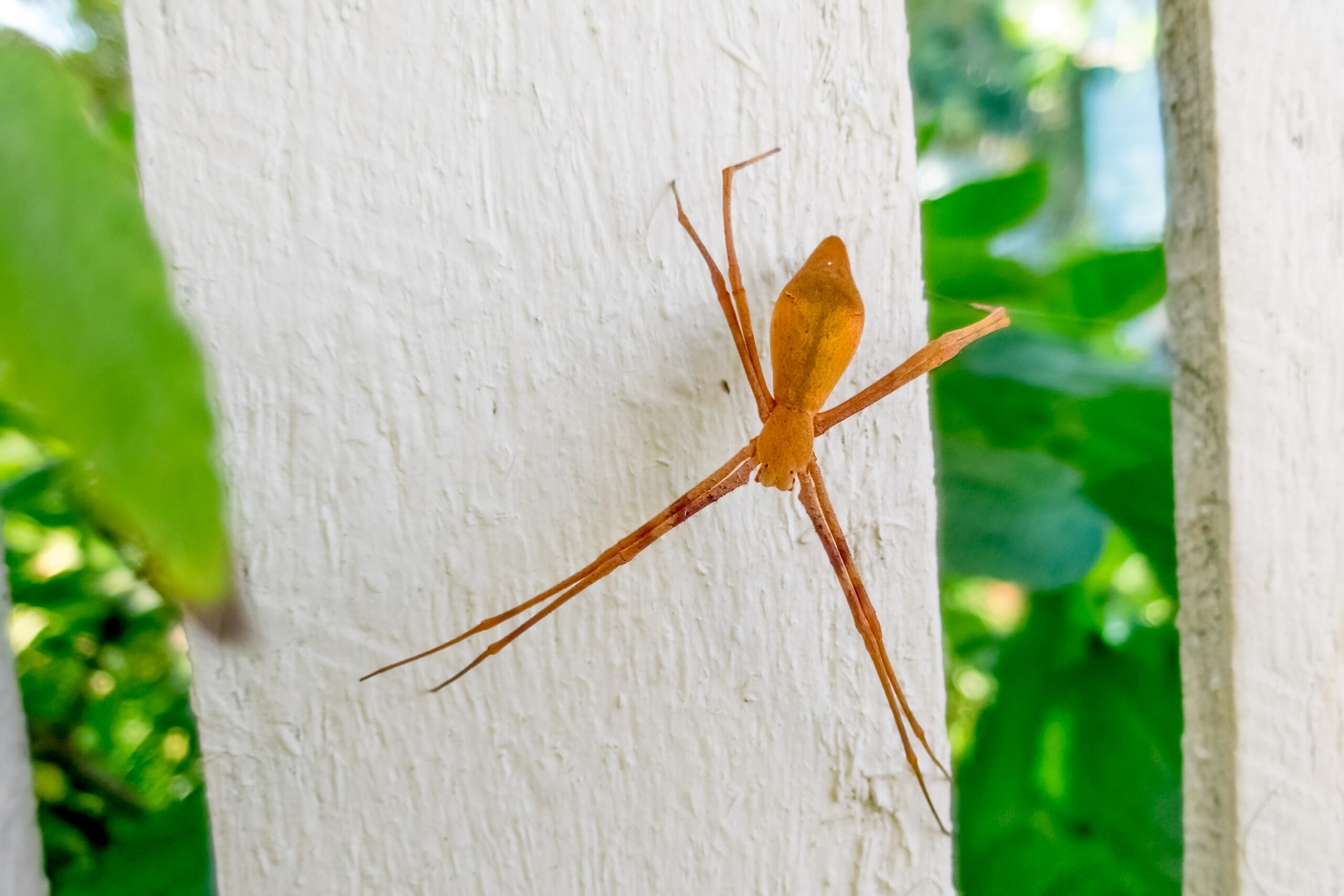Rod Hobson
As many of my friends, including several of the Toowoomba Field Naturalists, are now aware I have spent a good portion of the first four months of 2022 house bound following the total replacement of my left knee. To say the least this gave me a great deal of time for sombre reflection on life in general and, for Betty, on the institution of marriage in particular.
About two months into my confinement, I was able to get about our yard with the aid of a stick and renewed some of the simple delights of the suburban garden that have been, over the years, displaced by frantic dashes around the country in pursuit of the exotic and fabulous. I became reacquainted through circumstance with the beauty of the commonplace, the gorgeous livery of a male Australian King Parrot, the spectacle that is a female Orchard Swallowtail or the aerial wizardry of an Australian Duskhawker.
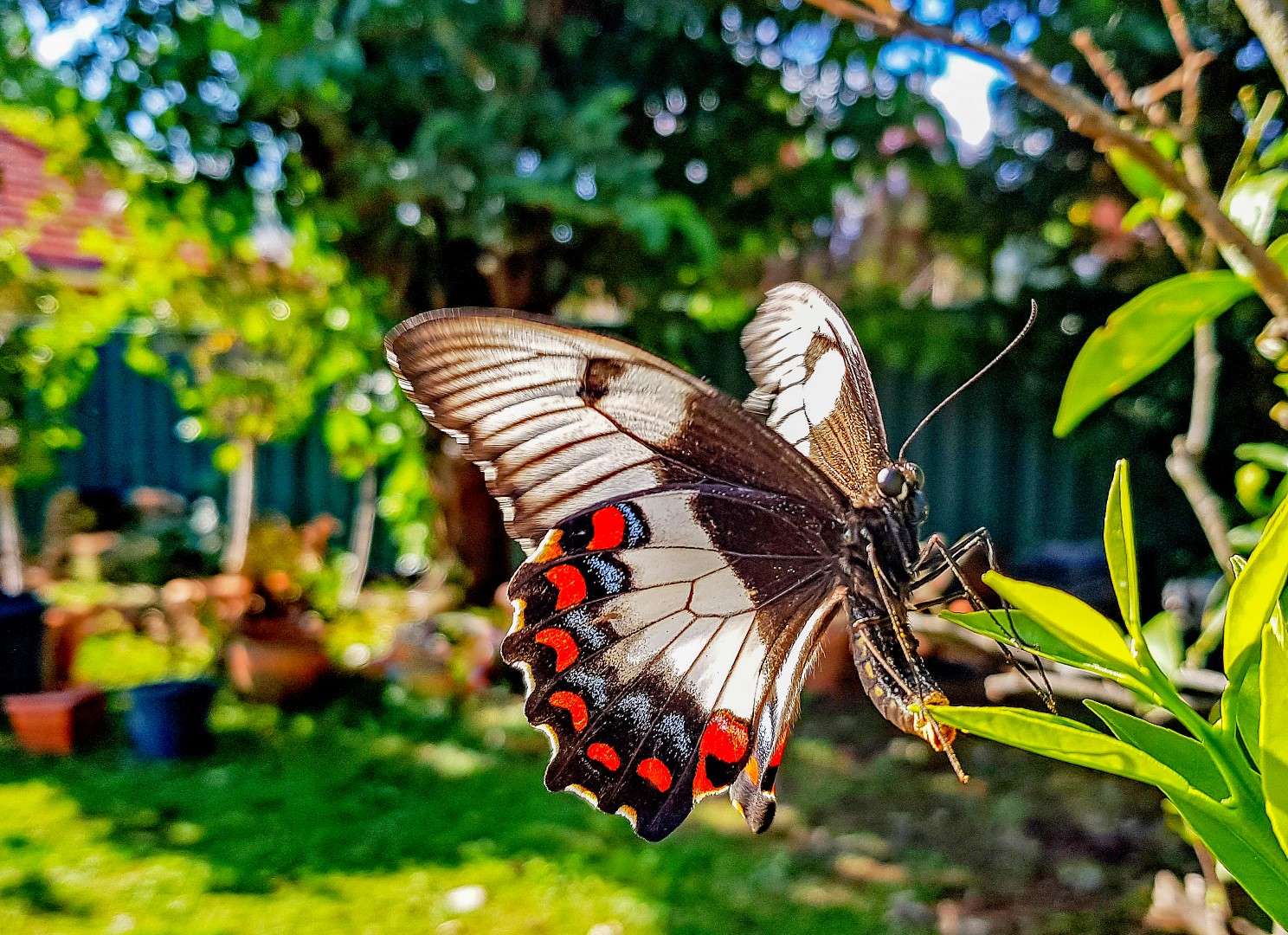
Aerial sunlight backyard dancer. Orchard Swallowtail (Papilio aegius), Toowoomba. (Photo: Robert Ashdown)
I also caught up on a lot of reading. This has resulted in the following amalgam of reminiscences, obscure facts, and trivia that, hopefully, will bestow upon the reader some moments of pleasure no matter how tenuous are the strands that compose the essence of the story, an invalid’s story, anecdotes of a curmudgeon. In other words, a rambling discourse on things varied and curious.
To begin gathering the disparate mycelia that should, hopefully, form a cogent whole first credit must be given to my old mate and fellow Toowoomba Field Natter Michael Rooke. Michael is an old newspaper man and of my vintage. We have a great fondness for words and are stout defenders of the semi-colon. And not to mention the interrobang. Etymology and punctuation are our thing. Just the sorts of blokes to add glamour and glitz to your dinner party! Another passion we have in common is the local news, though not the stuff about a new bikeway, netball team or shopping centre but what’s going on around your back yard, local swamp, or patch of remnant bushland, which denizen feathered, furred, or squamous has popped up there lately. How many of your avocados, tomatoes or electrical wires did it chew through? The guts of a good newsletter. Michael has been the untiring champion of local content for many a year now and has contributed more than his fair share to our newsletter. Thanks, Michael.
As I said my recent forced confinement to barracks gave me ample spare time to sit and think, usually on our back stoop if a sunshiny morning. During that time, a Satin Bowerbird established his bower under the drooping branches of one of our avocados. Australian Admirals, White-banded Planes, Tailed Emperors, Pale Triangles and Tau Emeralds, usually occasional visitors to our yard at best were around in numbers. One morning, by our front stairs, as I was staring, mind blank, into our overgrown flower garden I suddenly became aware of the skeletal form of a male Net-casting Spider Deinopus subrufa suspended, as if frozen in time, in an angle of the house wall. I’ve often encountered this spider in our yard over the years and it certainly appears to be a common local species. It’s a favourite of mine and never fails to elicit comment from people who encounter it.
Over this last spring/summer I have received two reports of this spider from the Ashdown residence east Toowoomba, and one each from the Thorn Street wall of the Toowoomba Office Works and from Duggan Bushland and near Bunkers Hill State School. Further afield I’ve received recent reports of the spider from a friend’s house yard in Redbank Plains (J. Sparks pers. comm.). There is a skate park, one of those lekking grounds for disenchanted youth, near Lake Annand. For all this summer a female Net-caster has been in residence there tucked up under a concrete lip out of sight, out of mind despite the almost constant hubbub around her.
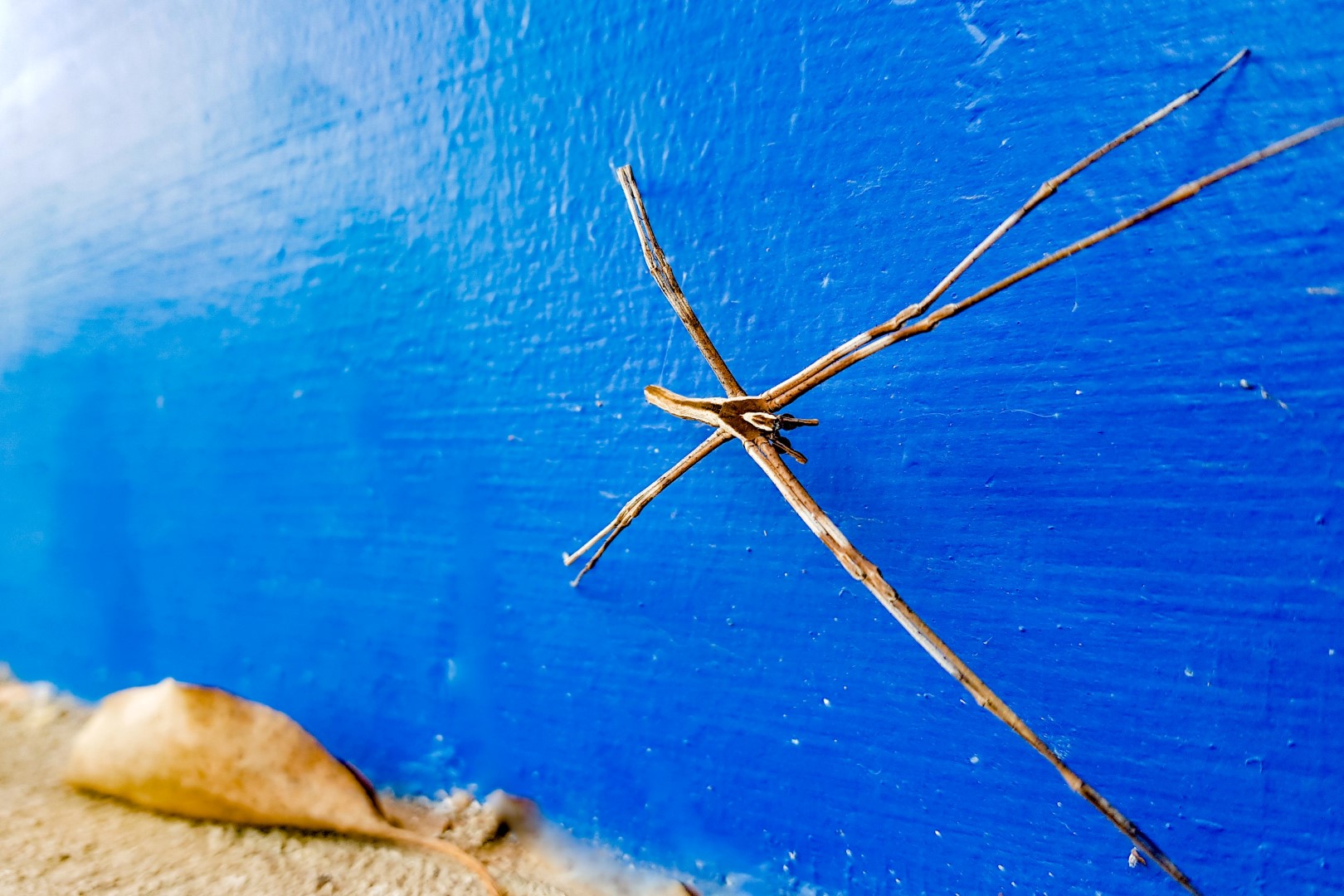
Adult male net-casting spider (Deinopsis subrufa) not caring a jot about camouflage as it hangs about the wall of the Toowoomba Office Works. (Photo: Robert Ashdown)
One of my first spider books that I acquired in my early teenage years was Keith C. McKeown’s Australian Spiders first published by Angus and Robertson in 1936 as Spider Wonders of Australia. Mine is the version revised by N.L. Roberts and published by Sirius Books in 1963. I still have it and it is beside me as I write. I remember seeing my first net-caster long before I got this book. It was holed up under Pat Walker’s Japanese Honeysuckle vine at his home in Jennings Street. I have never lost my fascination with this spider. The Net-caster Spider goes under the aliases Ogre-faced Spider, Stick Spider, Gladiator Spider and Retiarius, the last of which is used by Mc Keown in his book above. I’ve always preferred Retiarius likely from the early influence of this book. The scientific name of our local net-caster is Deinopis subrufa (family Deinopidae). Deinopis is from the Greek deinos meaning fearful plus opis meaning appearance. Deinopis subrufa was described by the German entomologist and arachnologist Ludwig Carl Christian Koch (1825-1908). Its specific epithet means light red. The light red, fearful-looking spider.
The Deinopidae was first described by the British civil servant and entomologist William Sharp Macleay (1792-1865) (Macleay, 1839). This is a pantropical family of sixty-seven species in three genera, the Asianopsis, Deinopis and Menneus (= Avella) (Friedrich and Lehmann, 2020). The World Spider Catalog (Natural History Museum Bern, 2021) lists nine species of Asianopsis confined to SE Asia and China and fourteen species of Menneus found in Australia as well as Lord Howe Island, New Caledonia, “possibly New Guinea”, and South Africa. The Catalog lists Deinopis as the largest genus (44 species). It is found on all continents except for Europe and Antarctica. All Australian Deinopis were described before 1900 with six species entering the literature. These are (fasciata, ravida and tabida, Queensland; schomburgki, South Australia; unicolor, Western Australia and subrufa, eastern Australia). All except subrufa are now considered nomen dubia. Nomen dubium (doubtful name) is a name used in zoology that is of unknown or doubtful use i.e., dodgy. This also includes a spider originally named Deinopis bicornis that is now recognised as subrufa.
Certain individuals of subrufa have two dorsolateral bumps halfway along their abdomen that initially gave rise to bicornis being thought a separate species. Toowoomba arachnologist Dr. Ron Atkinson, and other authorities (Volker et al., 2014; Whyte and Anderson, 2017) acknowledge that the taxonomic status of Australian Deinopis, though, is not yet fully resolved; a refrain echoed ad infinitum by taxonomists in disciplines not solely confined to arachnology. The local species, however, is certainly subrufa (R. Atkinson pers comm., 01/06/2022). Two subrufa, a male and a female have even managed to cross The Ditch to New Zealand (Forster and Forster, 1999). There have been no recent observations of net-casters, however, in that country.
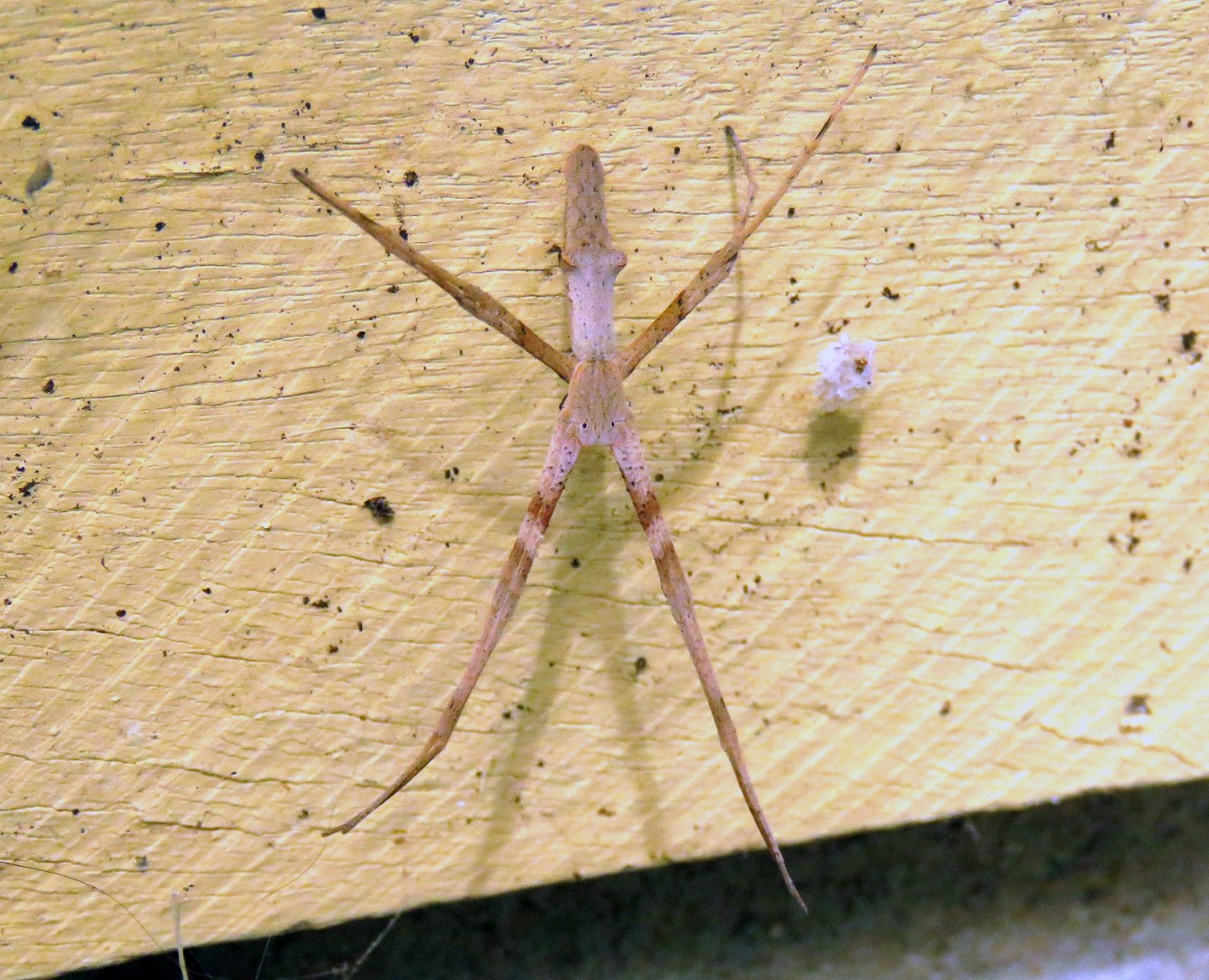
Deinopis subrufa with the pair of dorsolateral “bumps” that led to this form being originally described as Deinopis bicornis. (Photo: Jane Sparks)
The Menneus or hump-backed spiders were originally placed with the cribellate orb-weavers but moved to Deinopidae in 1967. There are seven species in Australia (Coddington et al., 2012) that include two Queensland species viz. aussie and trinodosus. The pair are found in New South Wales, as well with aussie extending to Lord Howe Island. Aussie is suspected of being in New Guinea, too. For brevity in scientific names, it be hard to go past the Western Australian species Menneus wa. And who said taxonomists are humourless types. Western Australia also has Menneus quasimodo. Howzat for a name for a hump-backed spider? The net-caster genus Asianopis was only described in 2020 (Lin et al., 2020a) and is absent from Australia. The three genera have all adopted ‘net-casting’ for procuring prey, though with slight variations in techniques across the genera.
Net-casters have an elongated body hence Stick Spider being a popular vernacular. The legs are long, spindly with the third pair being the shortest. Body length across the family ranges from 5-28 mm. The prey capturing strategy within this family is unique. The spider’s snare is produced from an organ on the ventral side of the abdomen near the spinnerets called a cribellum. The snare is entire and broad resembling a net hence the spider’s name. This rectangular snare is held by the spider between their first three-pairs of legs with the spider, in turn, suspended by its hind legs by what is thought to be a reduced web. On the arrival of an unsuspecting feed the spider stretches its legs thereby expanding its net. Following the release of its fourth limbs the spider is free to throw its net over the prey. The net can be dispatched to capture aerial or ground dwelling prey. Aerial prey capture is more usual in the Menneus whilst Deinopis generally hunts pedestrian prey, however methods are not mutually exclusive (Volker et al., 2014). Prey as large as trapdoors and gryllacridid crickets are taken. To increase the spider’s net-casting efficiency it often deposits white faecal spots on the leaves below its ambush used as aiming spots by the arachnid. It’s a touch and go strategy and the spider is often left holding an empty net. The spider’s net is dismantled during daylight hours, and it retreats into the surrounding area where its lanky morphology and stoical demure provides excellent camouflage from hungry predators.
A closer scrutiny of Deinopis will quicky reinforce another of its trivial names, Ogre-faced Spider. It’s got a physiognomy that only a mother could love. The most conspicuous feature of the spider’s head is two massive staring jet eyes, the posterior median eyes in the crusty parlance of science. These, along with a huge set of jaws seem to almost comprise its entire ‘face.’ Four additional but miniscule eyes, by comparison, subtend these mighty, beetle-browed gogglers. There are also another two small eyes behind the posterior median eyes so, eight eyes in all for the net-casters, which is standard for most species of spider. Asianopis has similar-sized posterior median eyes, however these are smaller and more widely spaced in Menneus. Net-caster eyes are remarkable organs. They are far more efficient in gathering light than in animals such as cats and owls. This is despite the spider lacking the reflective layer (tapetum lucidum) present in the eyes of many vertebrates. The tapetum lucidum is a layer of tissue immediately behind the retina, a retroreflector that increases the light available to the photoreceptors (image forming cells). In our spiders a large area of light-sensitive membrane is produced within the eyes nightly which, since spider eyes lack irises, is rapidly destroyed by the arrival of day. The spider’s enormous posterior median eyes give the animal a very wide field of vision to complement its excellent night vision. The post median eyes of Deinopis are believed to be the largest ocelli relative to body size of any invertebrate with those of subrufa measuring up to 1.4 mm in diameter (Volker et al., 2014).
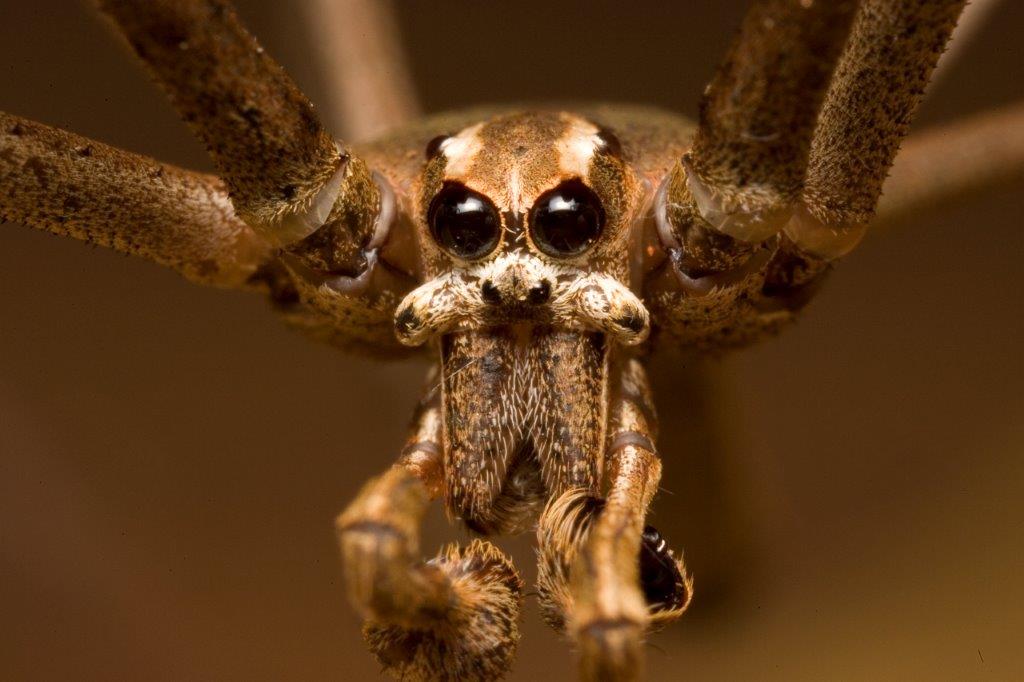
A male Deinopis subrufa. The two large, clubbed organs at the bottom of the photograph are the palps, the reproductive organs in male spiders. (Photo: Bruce Thomson)
These spiders mature in summer. Mating and egg-laying occurs in autumn with spiderlings emerging in spring. Hatched spiderlings remain massed in a communal web before finally dispersing. Egg sacs are round balls up to 10 mm in diameter. The sacs possess a tough and intricately woven silk exterior of an ochre-brown, dark-flecked colouration. These are hidden, suspended in low vegetation, and camouflaged with bits and pieces of twig and leaf-litter. Up to four egg sacs are produced. The reproductive process in these spiders is ingenious and best described by Whyte and Anderson (2017) quote, “In this family the male’s inseminating embolus is tightly coiled up to 20 times in a spiral. The female organ has corresponding coils to receive it. During copulation the embolus unwinds, rotating itself into the female in a marvel of sexual engineering.” The net-casters are truly one of the wonders of our bushland and the world of arachnids generally.
So, “now for something entirely different” to explain my preferred colloquial name for Deinopis subrufa viz. Retiarius I’ll return to my sunny doorstep earlier this year. I was contemplating my Retiarius when I noticed, nary a spiderspit away, a small clump of those flowers that have entered Australian iconography courtesy of our celebrity Housewife from Moonie Ponds. That plant, of course, is the gladiola Gladiolus sp., one of over three hundred species in the Iris family Gladiolaceae. Ours have valiantly rejuvenated themselves every other year despite being completely ignored by the homeowners. It dawned on me that, perhaps, the origin of this plant’s name came from the Latin gladius meaning sword. And so, it proved and refers to plant’s sword-shaped leaves.
The gladius was a short sword perfectly designed for close combat. It reached its zenith as a combat weapon in the hands of the legions of the Roman Empire. Roman foot-soldiers adopted this sword from that used by the Celtiberians in Hispania late in the Punic Wars (264-146 BC). The sword was also used in the Roman arena hence we also have the word gladiator or swordsman from this root. There were distinct types of gladiators and one, armed with a trident (fuscina), dagger (pugio) and a weighted net (rete) was known as the net-man (retiarius). The retiarius was usually matched against the secutor (follower or chaser) who was more heavily armed with a gladius and curved, rectangular shield (scutum). The secutor’s head was encased in a distinctive, claustrophobic helmet, with only two small holes for the eyes, to prevent a trident thrust into the face. The secutor, being much more heavily encumbered than the lightly armed retiarius had to finish the combat quickly before being overtaken by exhaustion hence his name of follower or chaser (secutor). The was also a gladiator who was known as the contraretiarius or contrarete. This was simply another name for a retiarius pitched against a second retiarius. So, hereby hangs my tale with three of my favourite subjects, zoology, history, and etymology coalescing on that sunny morning.
“What have the Romans ever done for us,” Reg, the leader of the People’s Front of Judea harangues his audience in Monty Python’s Life of Brian. Well, Reg, aside to aqueducts and roads they have bequeathed to us a great name for an amazing spider. Viva Retiarius may your casts be fruitful these summer eves.
I would like to thank Toowoomba arachnologist Dr. Ron Atkinson for his comments on the taxonomy of the Deinopidae. Ron’s sharing of his extensive arachnological knowledge over many years is also acknowledged. Thanks Ron.
References
- Coddington J.A., Kuntner M., and Opell, B.D. (2012). Systematics of the spider family Deinopidae with a revision of the genus Menneus. Smithsonian Contributions to Zoology. 636:12.
- Forster, R., and Forster, L. (1999). Spiders of New Zealand and their Worldwide Kin. University of Otago Press, Dunedin.
- Friedrich S. and Lehmann T. (2020). Second record of Net-casting Spiders in Peru. Spixiana. 43 (2): 304.
- Lin, Y.J., Shao, L., Hangii, A., Caleb, J.T.D., Koh, J.K.H., Jager, P. and Li, S.Q. (2020a). Asianopsis gen. nov., a new genus of the spider family Deinopidae from Asia. Zookeys 911; 67-69.
- Macleay, W.S. (1839). “On some new forms of Arachnida” in Annals of Natural History. 2 (7): 1-2.
- Volker, W.F., Baehr, B.C., and Zborowski, P. (2014). A Guide to the Spiders of Australia. Reed New Holland Publishers Pty Ltd., Sydney.
- Whyte, R., and Anderson, G. (2017). A Field Guide to Spiders of Australia. CSIRO Publishing, Clayton South.
[This article was first published in the July 2022 edition (775) of The Darling Downs Naturalist, newsletter of the Toowoomba Field Naturalists Club.]
Links
- Bruce Thomson. Australian wildlife photography
- Jane Sparks: Mildly Extreme. Survival stories of a directionally-challenged hiking hermit.

